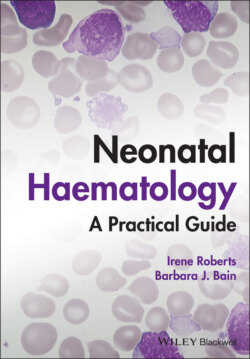Читать книгу Neonatal Haematology - Barbara J. Bain, Irene Roberts - Страница 36
Developmental megakaryopoiesis and thrombopoiesis
ОглавлениеAs for most of the other types of blood cell, there are many differences between neonates and adults in the processes that regulate megakaryocyte production (megakaryopoiesis) and platelet production (thrombopoiesis).132,133 These differences are particularly marked in preterm neonates and likely to contribute to the frequent occurrence of thrombocytopenia in sick neonates; they are important to consider in the investigation and treatment of neonatal thrombocytopenia (see Chapter 4).
The principal cytokine regulating platelet production in the fetus and newborn, as in adults, is thrombopoietin (TPO).34 Circulating levels of TPO, which is produced in the liver from early in fetal life,134,135 are higher in healthy term and preterm neonates than in adults.136,137 This does not seem to be a compensatory mechanism since TPO‐induced signalling is upregulated in cord blood megakaryocytes compared with adult megakaryocytes.133 Fetal megakaryocytes are also smaller and of lower ploidy than their adult counterparts, which may be the reason that they not infrequently circulate in the peripheral blood in preterm neonates (Fig. 1.17) and that cord blood‐derived megakaryocytes produce approximately 50% fewer platelets per cell138 (reviewed in references 139 and 140). Furthermore, unlike adults, thrombocytopenic neonates can only increase their megakaryocyte number, and not size, in response to consumptive thrombocytopenia.141 Nevertheless, fetal megakaryocytes appear to be cytoplasmically mature and express increased amounts of messenger RNA for the transcription factor GATA1 and increased surface glycoprotein 1b compared with adult megakaryocytes.133 These functional differences in fetal and neonatal megakaryocytes are now known to be accompanied by increased expression of genes associated with a number of signalling pathways, including those mediated by transforming growth factor β (TGFβ), insulin‐like growth factor (IGF) and Janus kinase 2 (JAK2), in fetal compared with adult megakaryocytes.142
Fig. 1.17 Blood film of a preterm neonate born at 24 weeks’ gestation showing a circulating megakaryocyte and giant platelet. MGG, ×100.
There are also developmental differences in megakaryocyte progenitor cells. The numbers of these cells are high early in fetal life and fall towards term and are higher in healthy preterm than term babies.132,143,144 Additionally, fetal megakaryocyte progenitors have more proliferative potential in vitro than those derived from adults, perhaps related to stronger activation of the JAK2 and mTOR pathways in response to TPO stimulation as found in cord blood megakaryocytes.133 These properties may explain how fetal and neonatal platelet counts are maintained at levels similar to those of adults, at least in the healthy fetus and neonate. The observation of increased numbers of reticulated (young) platelets in fetal compared with adult peripheral blood is consistent with this hypothesis.145
